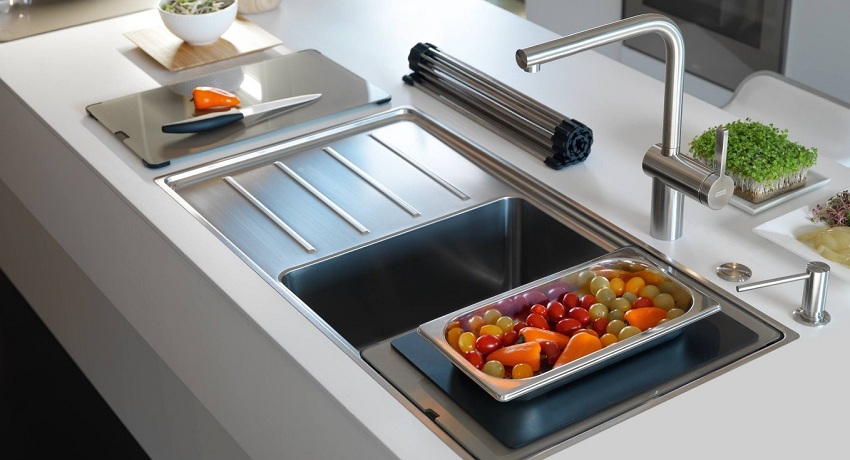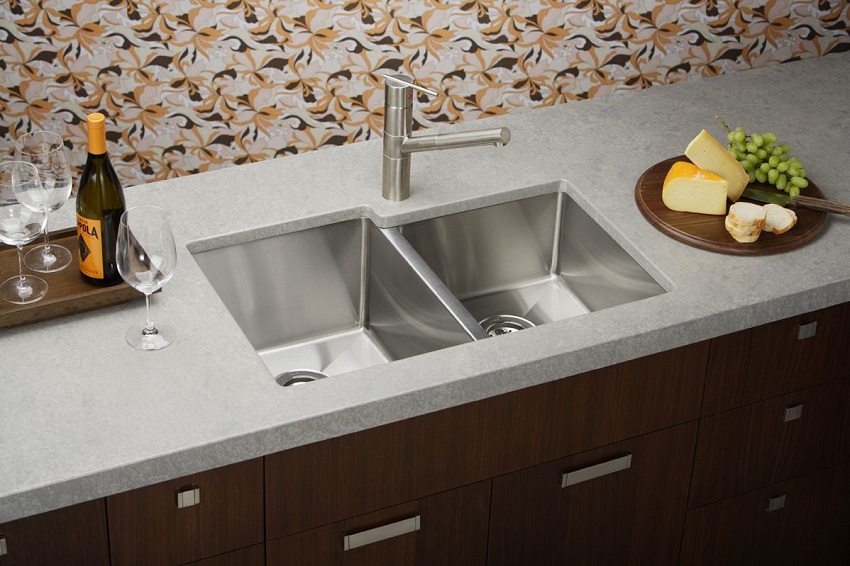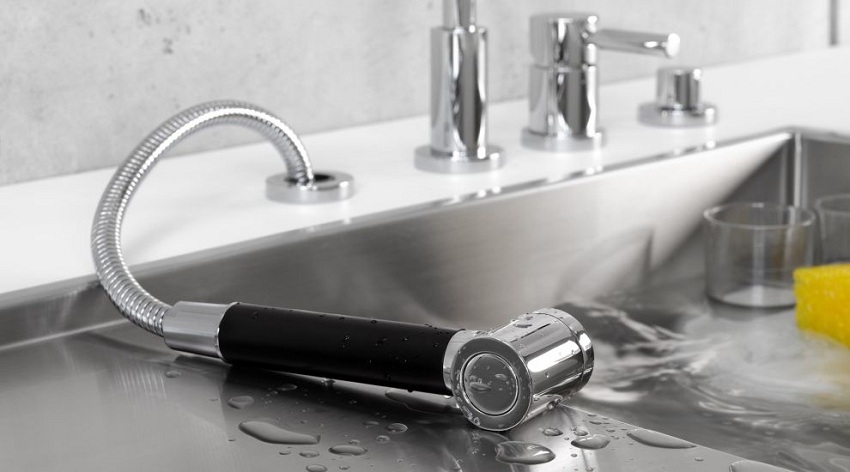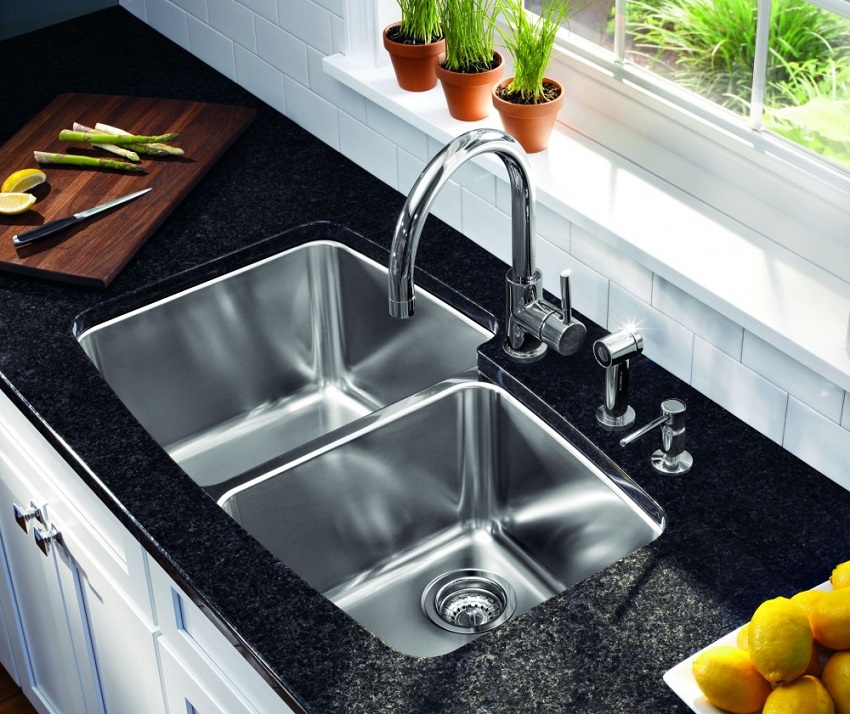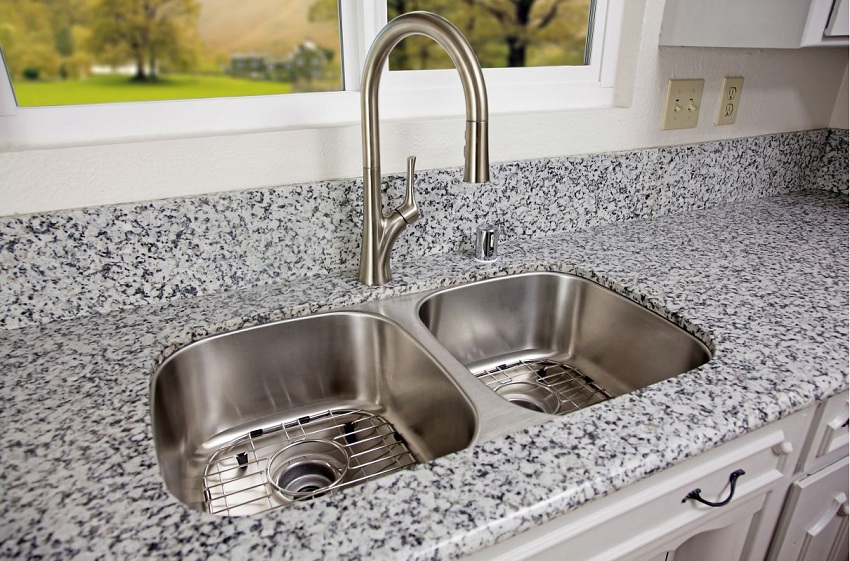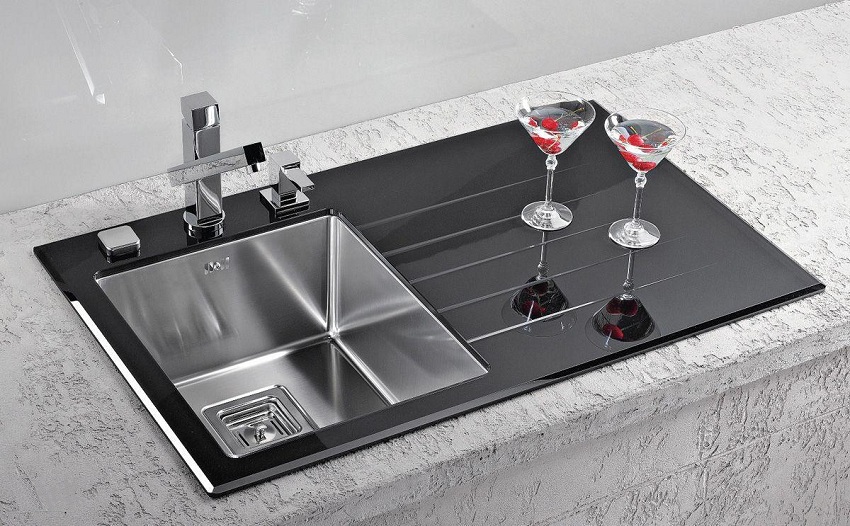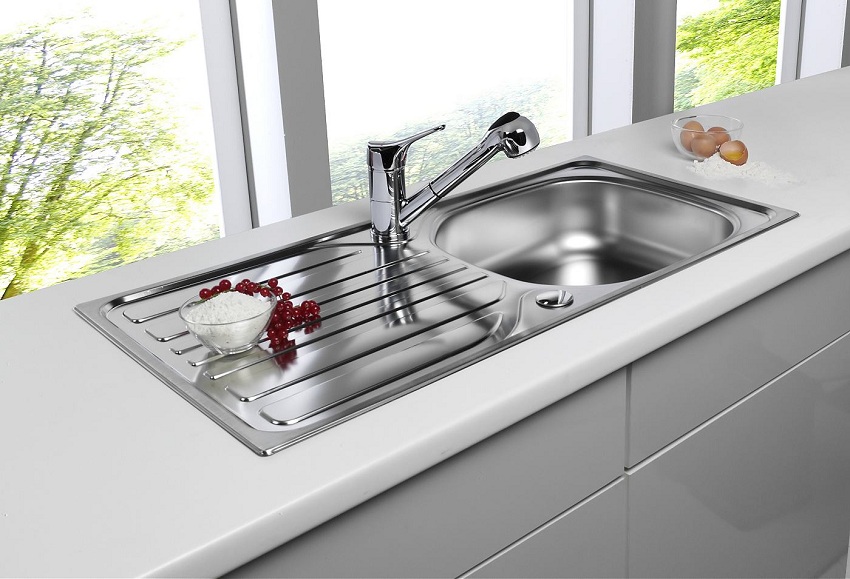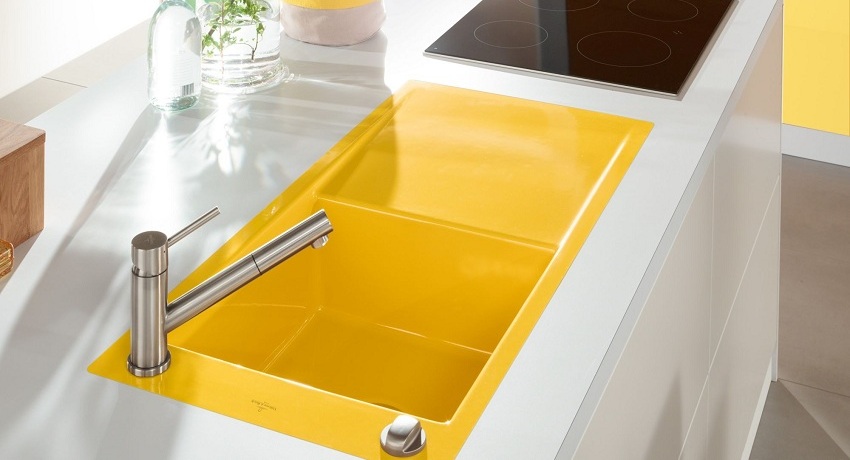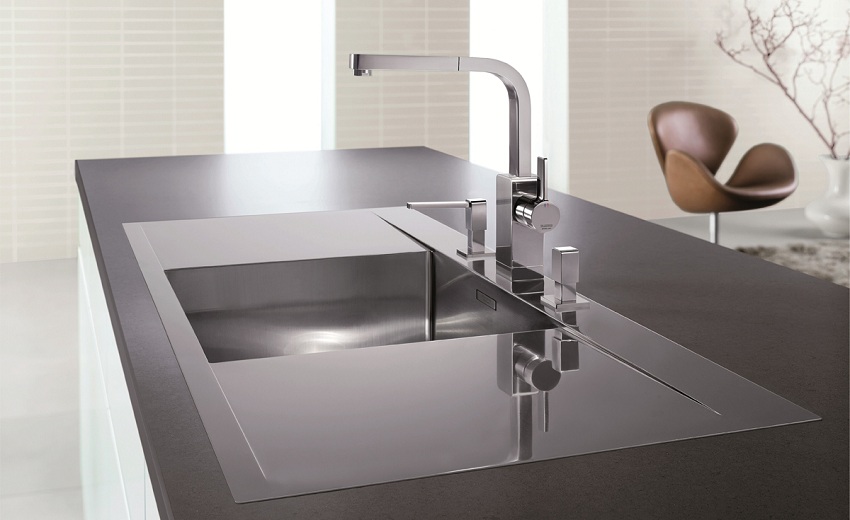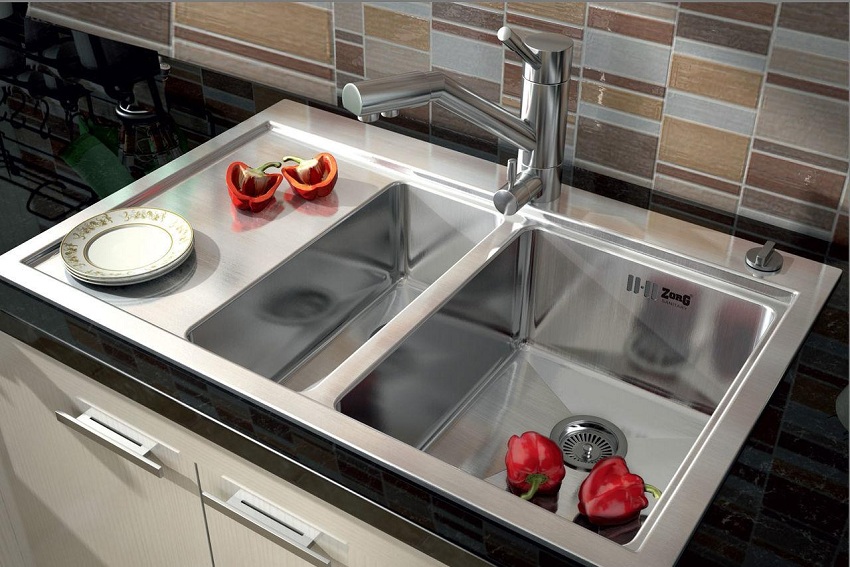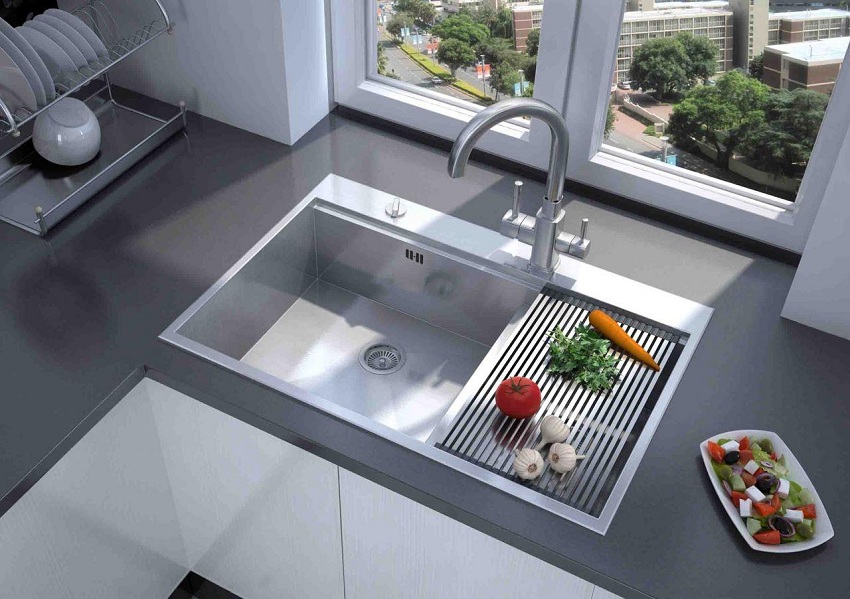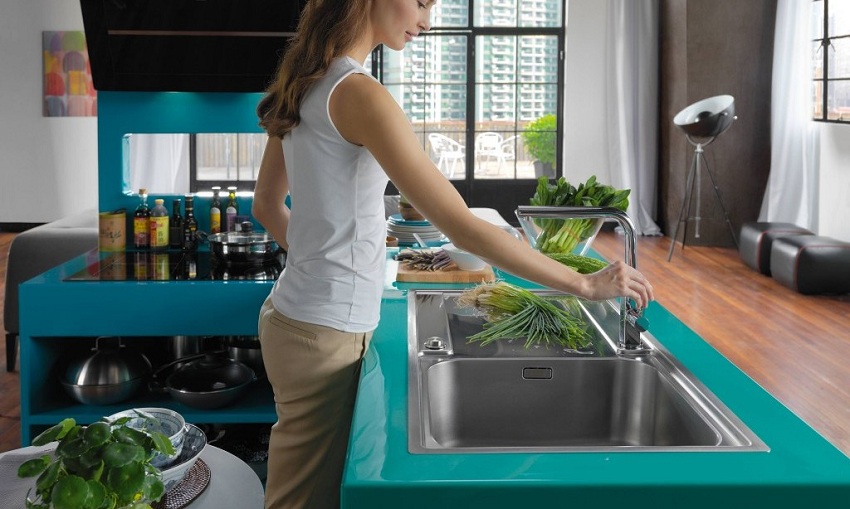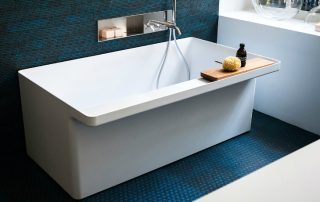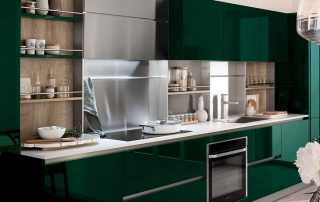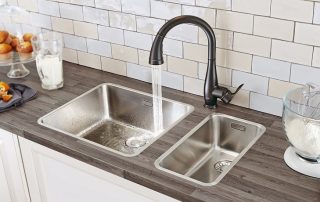The stainless steel kitchen sink is considered, along with the cooking stove, as one of the two basic elements of family dining. A well-chosen product will allow you to gently wash fruits, vegetables and other products. Used dishes can be quickly brought back to perfect cleanliness. Organization of the kitchen space in the chosen style will not be difficult for the owner.
Content [Hide]
- 1 Stainless steel kitchen sink: advantages of use
- 2 Stainless steel kitchen sink: what properties the material should have
- 3 Features of the technology for the production of metal sinks for the kitchen and their types
- 4 The choice of surface texture for stainless steel sinks in the kitchen
- 5 Design features of sinks made of stainless steel
Stainless steel kitchen sink: advantages of use
Stainless steel kitchen sinks are used in most homes. Among the reasons that determined the choice of this particular option from among those offered by sink manufacturers, we will single out the most significant:
- durability at a relatively low cost;
- ease of installation, combined with the ability to fit the product into almost any interior style;
- a wide range of products;
- compliance with hygiene requirements. The material does not contribute to the concentration of microorganisms;
- ease of maintenance.
- no damage will be caused by aggressive substances and corrosion;
- due to the elasticity, plasticity and strength of the material, mechanical damage is excluded from accidentally falling objects;
- the ability of steel to withstand heating up to 1450 ° C allows you not to be afraid of damage caused by the action of boiling water or heated dishes;
- exposure to temperature changes does not pose a threat to the material of the product;
- environmentally friendly design is easy to recycle, can be sent for recycling.
Note! The matte surface of some sink models is not only a design solution, but also an additional protection against mechanical damage.
The stainless steel kitchen sink, which is preferred by most consumers, has its own drawbacks. These include:
- the desirability of grounding. There will always be household appliances in the modern kitchen. Therefore, you should worry about safety measures when dealing with a material with high electrical conductivity;
- the appearance of lime deposits is inevitable. It is not difficult to get rid of the salt deposits that appear by wiping the surface dry after each use;
- Water beating against the sink makes a lot of noise, especially when the steel sheet is thin. Well-known manufacturers produce low-noise products using thick walls and installing rubber or plastic pads on the back of the structure;
- thin-walled products also tend to oscillate the mixer, which is displaced when the head changes because the steel sheet bends.
It is also possible to cope with the noise on your own. It is enough to apply a layer of ordinary polyurethane foam to the back of the sink bottom and let it dry for 24 hours.
Note! It is best to choose a sink with a remote control drain, then you do not have to dip your hands in dirty water to remove the plug.
Damage in the form of deflection of the steel surface can occur when a heavy, pointed object falls. True, this scenario seems extremely unlikely.
Stainless steel kitchen sink: what properties the material should have
The sale of a quality product is accompanied by the provision of a passport, which necessarily contains a mention of the type of steel used and the compliance of the steel grade with the Russian standard R 50851-96 or the international standard ISO 9001.
Manufacturers set the sheet thickness within a fairly wide range - from 0.4 mm to 1.2 mm. It is made from steel of the following brands:
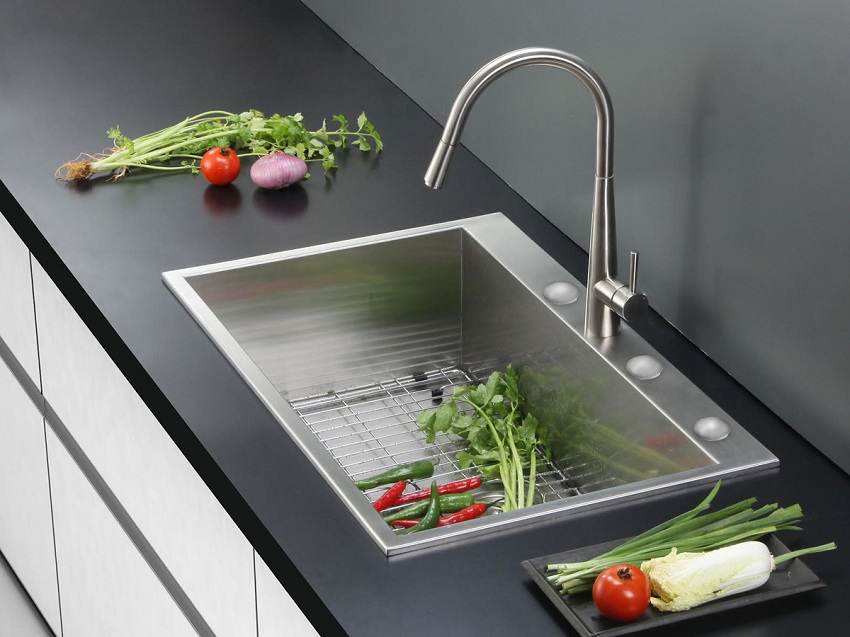
A sink made of high-quality food-grade steel will cost more than a conventional stainless steel sink
AISI304 (other designations may be used in the marking - 304 or 08X18H10). When purchasing a product manufactured by a European manufacturer, you may come across such labeling options - (EN) 1.4301 or (DIN) X5CrNI18-10. In an alloy marked in this way, the carbon content is assumed to be below 0.8%, a combination of chromium (18%) and nickel (about 8-10%) is considered ideal. This option is preferable, since special food grade steel is used. To buy a sink for a kitchen made of stainless steel of this brand, you will have to pay a relatively large amount.
AISI204. Other marking - 204. Steel grade 204 is easier to process, which affects its cost and the cost of products made from it. Buying a 204 stainless steel sink, you will be able to spend less money. It will not last so long, because the alloy has much less chromium, which provides strength. Even more important is the low nickel content, which resists corrosive processes.
The alloying of the steel used in the manufacture of the sink affects the strength, ductility and corrosion resistance, manifests itself in the characteristic gloss of the surface, which is easy to polish.
Ha note! Sinks with a mirror surface are usually classified as "luxury" and contrary to popular belief, caring for them is many times easier than for others.
Not too conscientious manufacturers of stainless steel kitchen sinks are made of inferior quality steels, which are intended only for technical use. When dealing with material with Russian marking 12Х17Г9АН4 or European DIN - X8CrMnNi188, it should be understood that AISI202 steel is used. Therefore, it is quite possible that over time traces of corrosion will appear in places of stress (bends or seams), the color will change, and the surface will be covered with structural spots.
Therefore, you should not purchase a stainless steel sink for the kitchen through an online store, but select it in a real shopping center so that you can be sure of its quality not only through visual inspection. Namely: a magnet will help to understand that the structure is made properly, from an alloy with properties suitable for use in the kitchen.It is assumed that its sliding on the surface of the product should be unimpeded. The sticking of the magnet to the vertical part of the structure unmistakably indicates the low quality of the material used.
Features of the technology for the production of metal sinks for the kitchen and their types
You can make a stainless steel sink by using one of two methods: welding or stamping. When deciding which sink to choose for the kitchen, this aspect also has a certain value.
The manufacture of welded sinks involves the connection of several parts. Using welded seams, the bowl and the base are connected. The most problematic part of such a design is precisely the welded seams, in the place of which, with improper quality of performance, leakage can begin over time. The cost of welded sinks is much higher than stamped ones. The explanation lies in the advantages of using welding capabilities, which are much greater than with stamping:
- item-by-item manufacturing allows you to show great flexibility in modeling during manufacturing, to significantly improve the quality of both individual parts and the structure as a whole;
- the use of a steel sheet of greater thickness makes the structure more durable, reliable and less noisy;
- in terms of depth, shape and dimensions, finishing, the assortment of welded products is very diverse.

Kitchen sink, complemented by a storage compartment for small items and a container for collecting waste
The polishing of the seams makes them completely invisible. An inset sink of considerable depth for a large kitchen set, which can also be used in a catering establishment, is made exclusively by welding.
Stamped sinks, devoid of welded seams, will find a place in the kitchen, where the operation of the product is not expected under intense conditions. Stamped structures are carried out using special machines. The use of solid steel sheet in a simplified process has a positive effect on cost. The disadvantages of the stamping method include the possibility of unequal surface thickness in case of violations of the execution technology. In addition, it will not be possible to obtain a product of sufficiently large dimensions and depth due to the limitations arising from the use of standard steel sheet.
For a long time, the depth of the bowl in the manufacture of sinks by stamping did not exceed 150 mm. Now a number of manufacturers have managed to overcome this drawback by increasing the competitiveness of their own products.
Where to install the overhead and built-in sink in the kitchen countertop
One of the important factors affecting the choice of a sink is the way in which it is planned to be installed.
Based on the installation method, kitchen sinks are:
- embedded or integrated;
- invoices;
- mortise.
Overhead sinks are equipped with Khrushchev kitchens with a sink in the corner.
Note! Cheap overhead sinks are not equipped with mounts and must be purchased separately. If you dispense with the retainers, the sink will move during use.
An overhead sink is easy to install. It is placed on a floor stand, replacing the table top. An important advantage of this design, in addition to the elementary ease of installation and low cost, is the thickness of the steel sheet - not less than 1.0 mm. The connection to the water supply system is accompanied by the manifestation of a disadvantage common for such structures - moisture ingress on the curbstone. Furniture can deteriorate quite quickly if you do not monitor the condition of the cracks.
Integrated sinks are kitchen sinks that are built into the countertop.The type of table top does not matter, but installation is fraught with difficulties, in particular, with milling. The bowl is usually lowered below the table top. The construction built into the kitchen furniture is quite expensive, redeeming it with its original appearance. They combine an integrated sink, as usual, with a countertop made of natural or artificial stone.
Related article:
Sink for the kitchen made of artificial stone: characteristics, features of choice and care
Features and composition of artificial stone. Models and colors of artificial stone sinks for the kitchen. Operational characteristics. Pros and cons.
What are the features of the inset sinks for the kitchen
Most often, a flush sink is installed in kitchens. The versatility of this type of design allows:
- install it exactly like an overhead sink;
- place over the countertop. Only mortise models can be used if there is a chipboard tabletop. The sides of the sink will be equipped with a protective barrier to protect the base of the furniture from moisture ingress;
- A sink for the kitchen, recessed under the countertop is another option, more expensive. Under-counter kitchen sinks work well with stone (natural or artificial) materials.
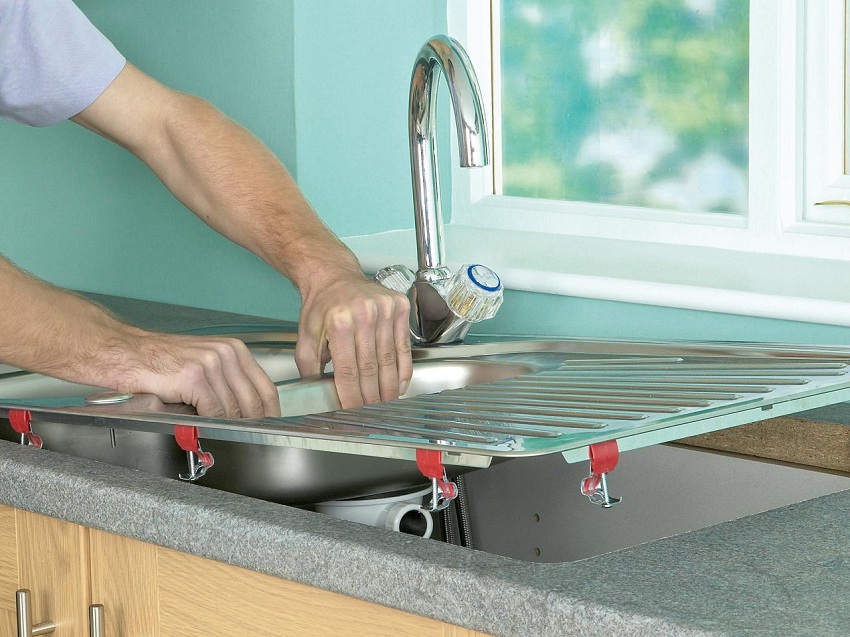
Installation of a flush stainless steel sink in countertop
Installing a sink in a countertop in a kitchen or placing a sink for a kitchen under a countertop is much more difficult than just stacking a sink on top of a cabinet. Therefore, the cost of this type of mortise models is much higher.
Such a structure is inserted into an opening cut using a specific template. The complete set includes special mountings. After finishing the installation, you will need to seal the joint between the sink rim and the countertop in order to exclude moisture and damage to the furniture.
Most buyers buy a stainless steel cut-in sink due to its convenience, hygiene and relatively low cost.
On a note! Mortise sinks are suitable for installation in a worktop made of any material, including artificial and natural stone.
The choice of surface texture for stainless steel sinks in the kitchen
The washing surface can be made in several versions.
Matt. The most common, matte, look is not too spectacular and conspicuous. But he has an important dignity for any housewife who does not have unlimited time to stay in the kitchen. Caring for a stainless sink with a matte surface is easy and time consuming. In addition, you can choose a matte surface, complemented by a moth-eye pattern. Such a surface looks like a textured one, for example, under satin or linen fabric. It looks natural and original, brings attractive features to the kitchen interior.
Glossy. The glossy surface can be polished to a mirror finish. A stainless sink with a glossy surface can be successfully integrated into the interior of a high-tech kitchen. An urban space full of glass and nickel-plated surfaces is quite suitable for such a product.
Textured (embossed). Smooth and shiny "satin" surface will have to be provided with constant close maintenance to get rid of the constantly appearing marks from drops and the smallest scratches. A textured surface with a decor in the form of a natural fabric, for example, linen, or microla can be installed without fear of streaks and accidental scratches. But there will be certain difficulties associated with the care of such a surface.
Useful advice! A sink with a matte or embossed surface can be completed in a kitchen made in any style.
The application of PVD-coating, stylized in brass, precious metals or noble bronze, creates additional protection for the surface. The decorative coating can be used for design in classic style, Provence or country, minimalist or high-tech.
Design features of sinks made of stainless steel
The most important component of the sink is the bowl. In the classic design, it is single and its depth is 180 mm. Sinks with a depth of less than 160 mm are considered shallow, they are not very convenient to use, as they quickly fill up with water, and spray scatters far from the sink. At a depth of more than 200 mm, the sink is also not very convenient to use, since you will have to bend over it strongly.
According to the form of sinks are:
- square, with a side equal to 500 mm or 600 mm;
- rectangular. The most common options are 600x500 mm, 780x500 mm and 800x600 mm;
- round, with a diameter of 400-500 mm;
- oval;
- five- or hexagonal.
The drain hole can be 11/2 "in diameter, which is common and suitable for a regular siphon. Modern models have a larger drain diameter of 31/2 inches, allowing for a food waste disposer to be installed and draining water quickly.
For greater convenience, sinks can be equipped with side wings, one or two, which provide protection of the table top from moisture and mechanical damage and convenient placement of dishes.
Important! Welded models in the budget price segment can be equipped with wings made of cheaper steel. But visually, all the details of the sink look the same, so it is necessary to check with the same magnet.
Manufacturers complete high-quality sinks with various additional accessories, the usefulness of which is sometimes disputed by consumers:
- colander (troflex). The basket, similar to the usual colander, can be used for defrosting or washed food. Installed in the sink or next to;
- a cutting board (plastic or wooden). A one- or two-piece chopping board is attached to the edge of the bowl, allowing for shear;
- dish dryer... Having fixed it on a relief surface, allow moisture flowing from the dishes to be in the sink;
- disposer. The structure installed at the bottom of the drain is designed to grind waste that ends up in it, with the exception of solid objects, hair and threads. The dispenser is powered by electricity or water pressure. It becomes easier to wash the dishes, but you have to protect the device from getting these unwanted items.
The variety of stainless steel sinks is such that you can choose something suitable for a kitchen of any size, regardless of the style features.
